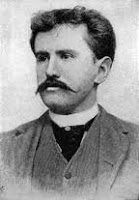Wednesday, October 12, 2011
Walking with Twain
O. Henry vs. Guy de Maupassant


“The Gift of the Magi” by O. Henry and “The Necklace” by Maupassant illustrate the two authors’ similar short story telling styles. In “Gift of the Magi” the two protagonist want to make each other happy by getting each other presents that will complement their most prized possessions. But because of their love for each other, they each give up their most prized possessions in order to be able to afford the gift for the other. Thus, ironically, neither can use their gift. Similarly, in the necklace, the protagonist loses an expensive necklace that was lent to her and has to replace it. Her husband and her spend the proceeding years of their lives working hard to pay of the price of the necklace, only to find out in the end that the one she had been given in the beginning was a mere replica and was essentially worth nothing.
As exemplified in their short stories both authors used the surprise-inversion technique, which Maupassant coined and Porter later followed, or utilized depending one’s stance in the argument. (Fusco) This method consists of a short introduction to the situation, allowing the reader to connect to the character, but not so much so that he feels cheated by the twist ending, followed by an event which requires a solution. However, the final outcome does not bring fourth what the characters or the reader expected. This method embodies irony, mainly situational, in order to show the twist
Writing in the same time period- the late 19th century to the early 20th century- both of their works focused on the topic of the lives of lower working class people who had to struggle just to get by. As seen in the before-mentioned stories, the conflict that lead to the ending was rooted in the characters need for or lack of money. This adds a sort of satirical element to their style because they are criticizing the poor distribution of wealth among the classes in society. Even though Maupassant wrote in France and Porter in America, the societal issues were similar.
The reason that many critics believe that porter modeled his style after Maupassant, instead of accepting that they had naturally similar styles, is because he started writing after him. Porter’s career as a short story writer didn’t really blossom until the later years of his life. This gave him a chance to see what style of literature society enjoyed at the time and he wrote based on what was popular instead of writing to the best of his potential. He is sometimes accused of wasting his talents.
Where Porter’s style differs from Maupassant’s is that he strays from the use of sexual instincts in his writing. Maupassant’s writing contains sexual images and innuendos, with which Porter shared little inclination. (Fusco) His stories also portrayed his naturalist philosophy. They showed that no matter how much the characters tried, their efforts had little effect on the outcome. What happened in the end was just by chance and the characters could not change natures will.
Ultimately, analysis suggests that Porter and Maupassant shared a common writing style. Although Porter and his supporters made a case that the author did not derive his style and techniques from the Frenchman, Maupassant, it is highly likely that his inspiration came from society’s fondness of this genre of short stories.
"The Necklace - a Short Story by Guy De Maupassant." Short Stories & Classic Literature from around the World. Web. 05 Oct. 2011.
Korb, Rena. "An Overview of 'The Gift of the Magi'" Literature Resource Center. Gale Cengage Learning, 2002. Web. 24 Sept. 2011.
Fusco, Richard. "Maupassant and the American Mainstream: Maupassant and O. Henry."Literature Resource Center. Gale Cengage Learning. Web. 5 Oct. 2011.
Food as a Means of Contrasting Cultures
Twain, Mark. A Tramp Abroad. New York: Harper and Brothers, 1921. Print
Twain, Mark. "At the Appetite Cure." Cosmopolitan. Issue 25. New York. 1898.
The Downplay of Innocence
“Alexander Porterfield, whose essay in 1925 tried to analyze Munro's art
and place in literary history, called his humor the ‘non-moral humor of a child’” (Cheikin121).
Despite critics’ claims that Saki’s work is childish and solely for the purpose of pleasure, his stories contain strong moral viewpoints. In the stories “The Open Window” and “Reginald’s Christmas Revel,” deceitful characters that lie and play practical jokes are portrayed positively, celebrating their cunning, while the gullible victims are characterized negatively. Though lying and playing practical jokes may be considered juvenile, Saki’s characterization, sarcasm, and the actions of his characters downplay innocence, advocating the moral lesson of cleverness triumphing over naivety.
2011. <http://www.americanliterature.com/Munro(SAKI)/SS/
TheOpenWindow.html>.
Web. 10 Oct. 2011. <http://www.americanliterature.com/Munro(SAKI)/SS/
ReginaldsChristmasRevel.html>.